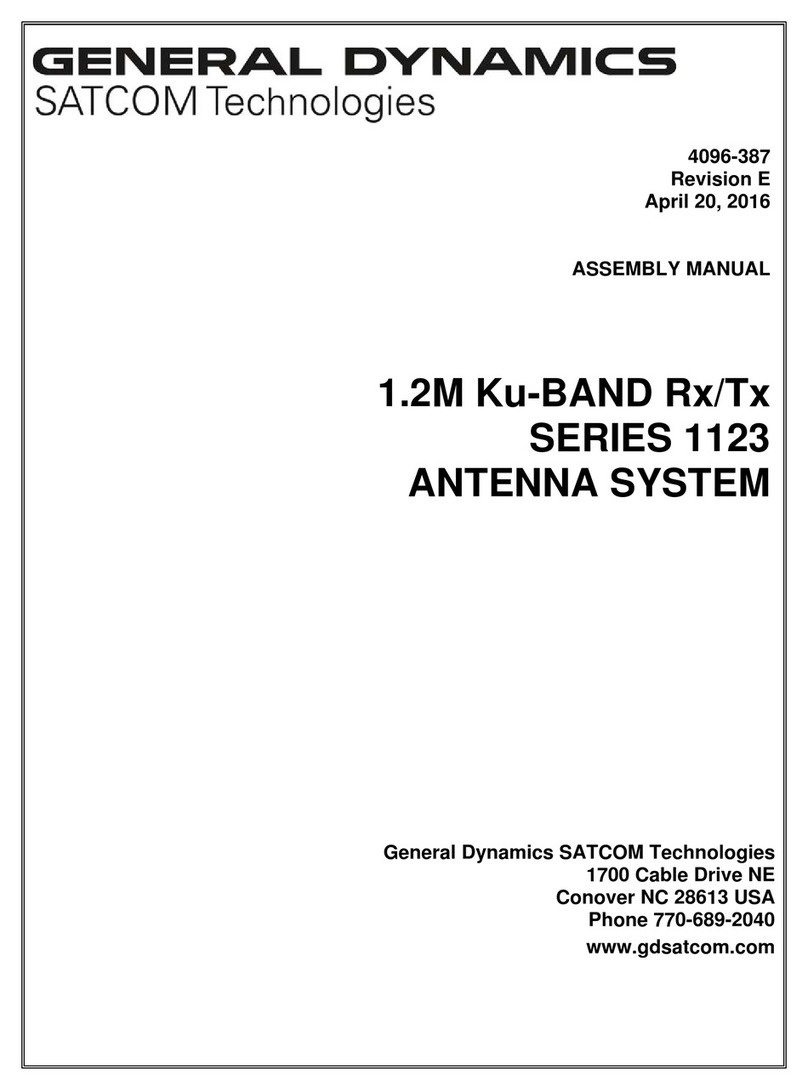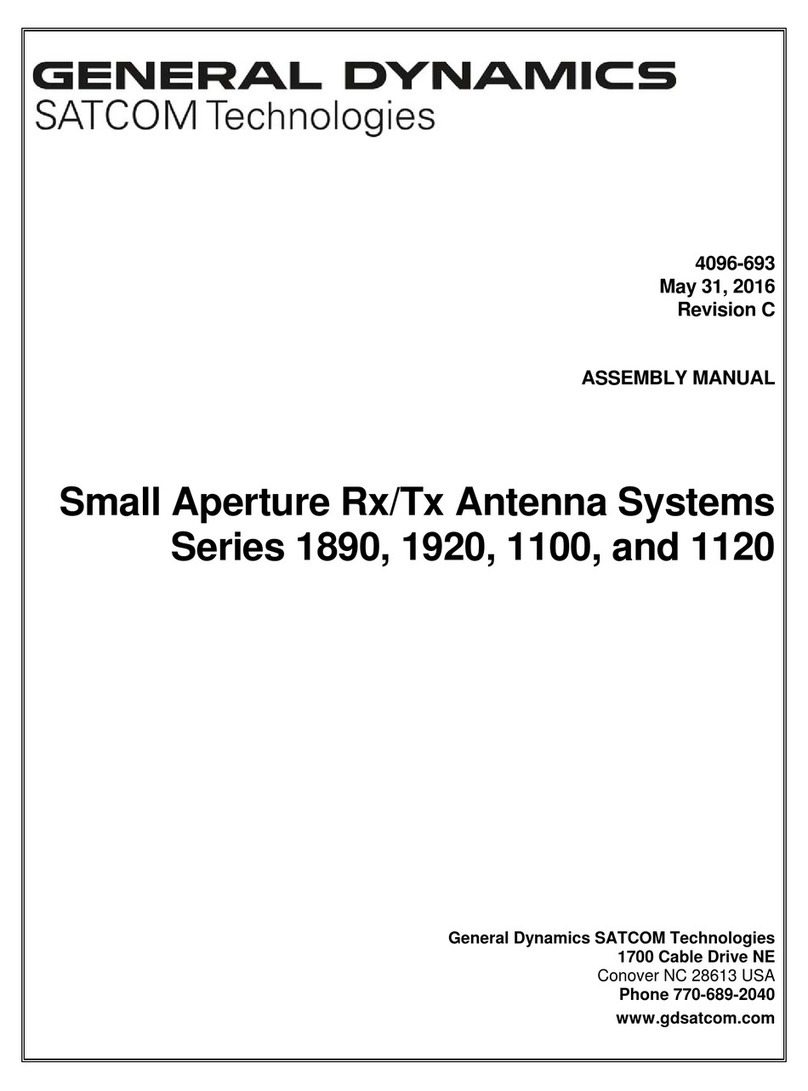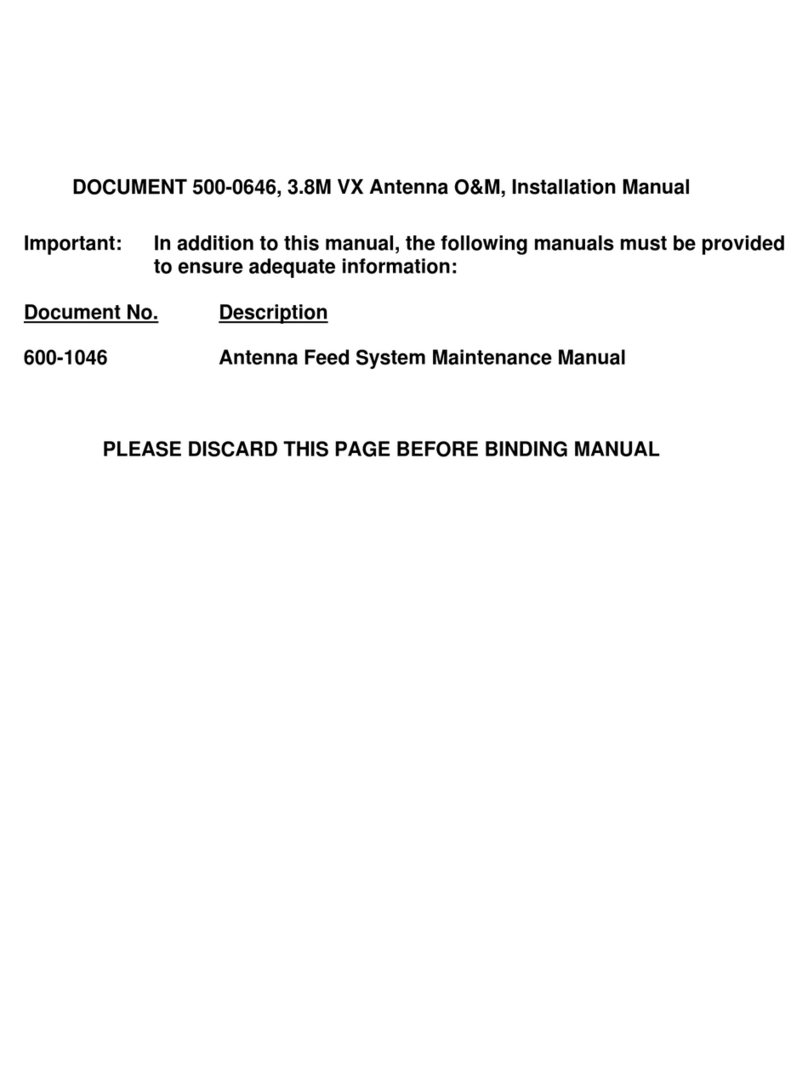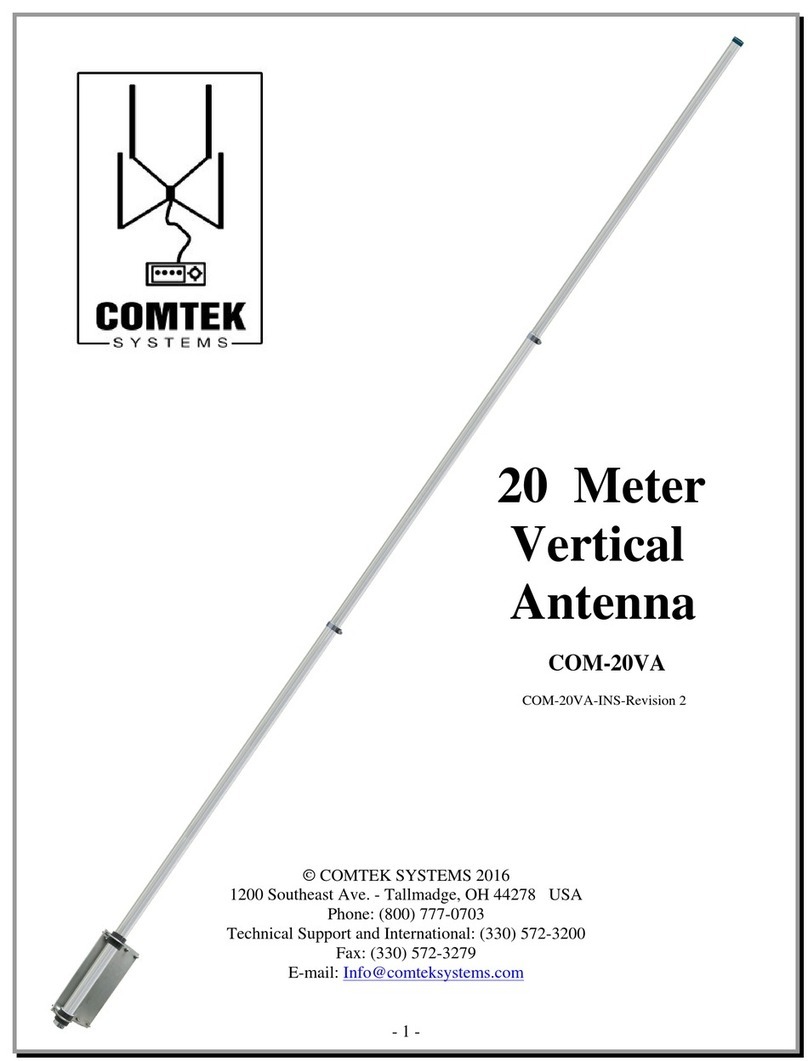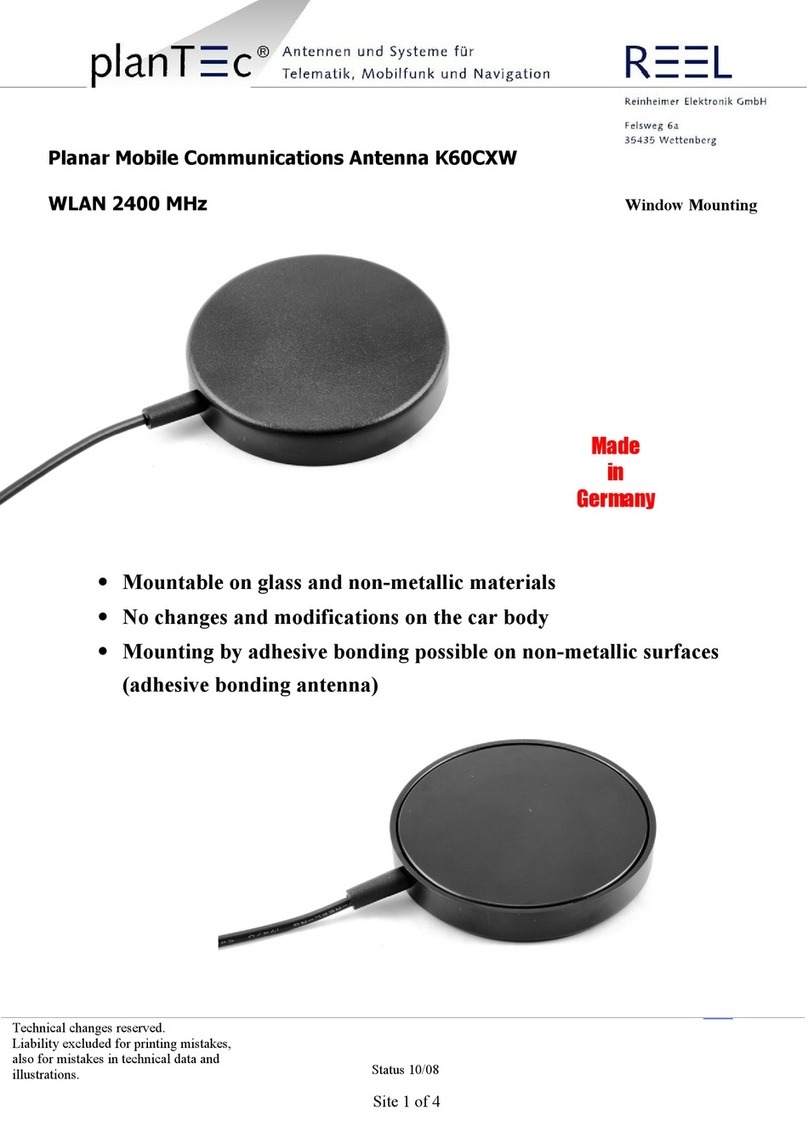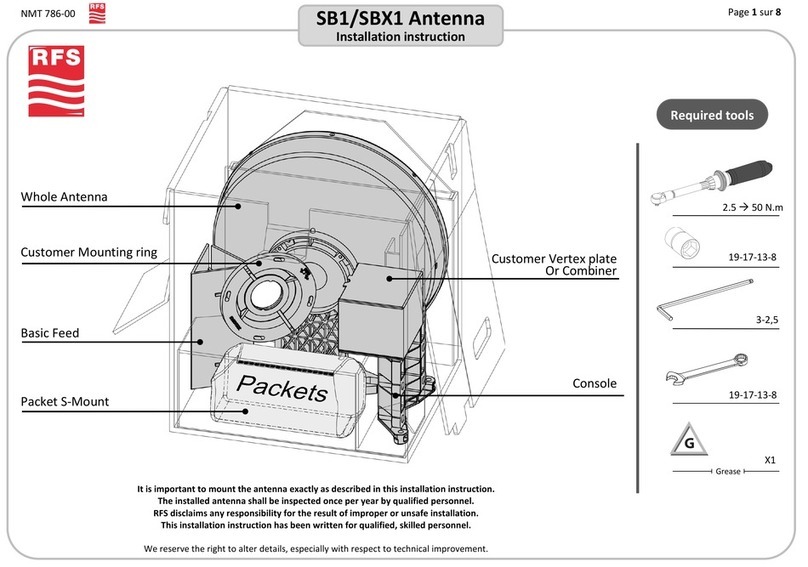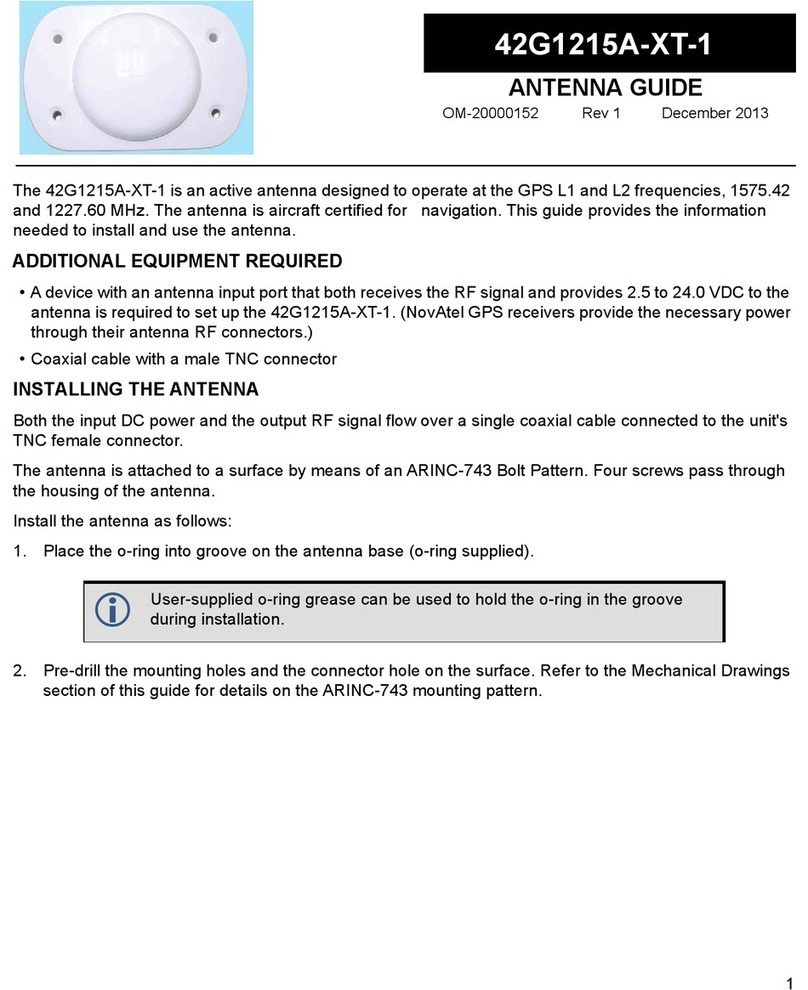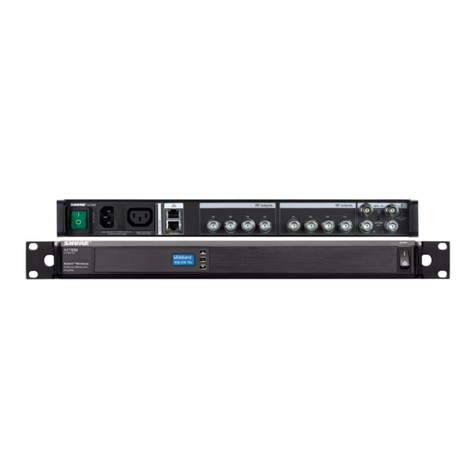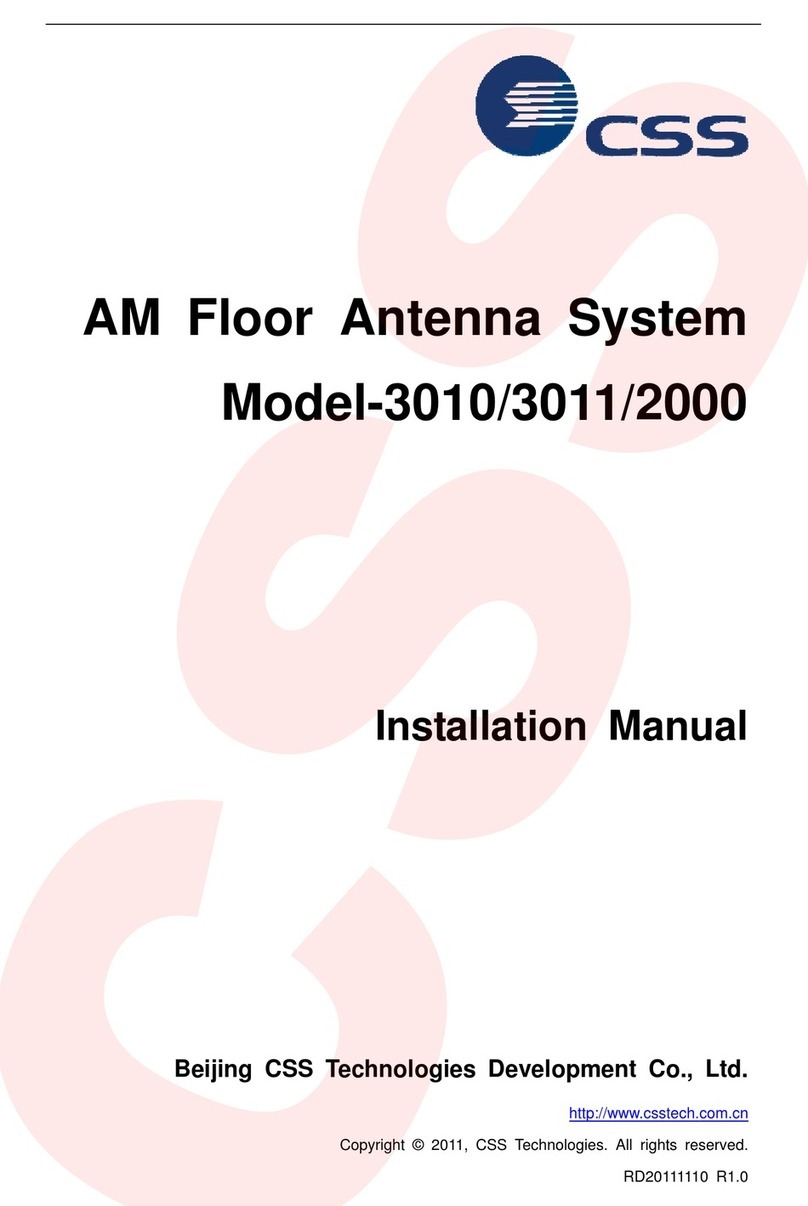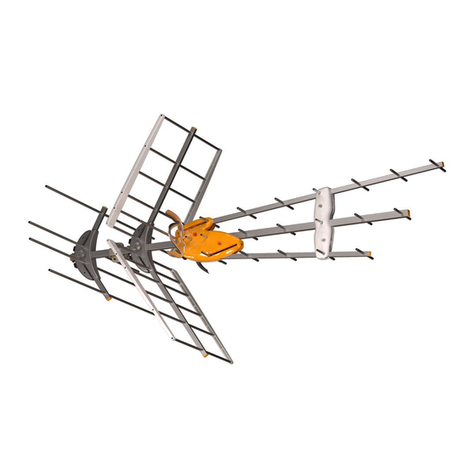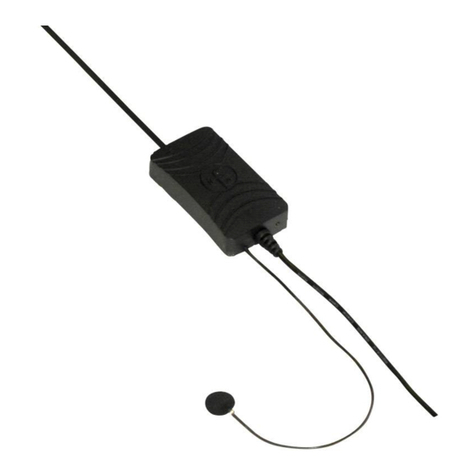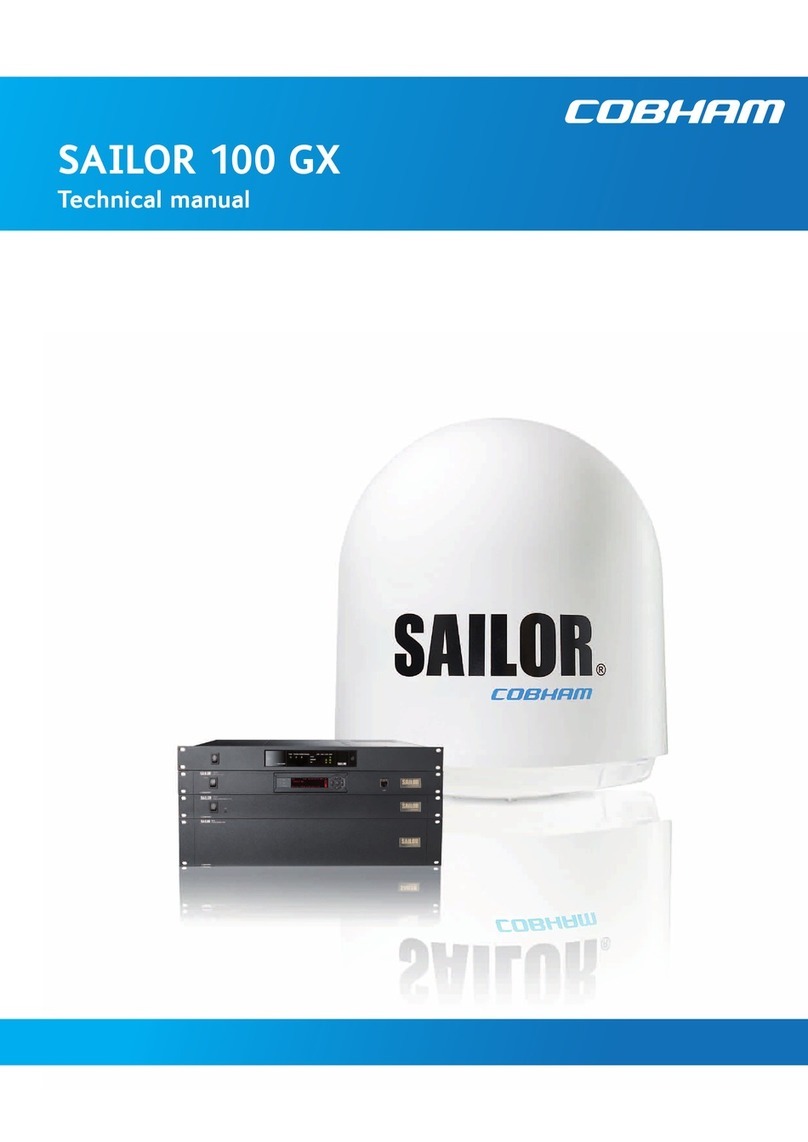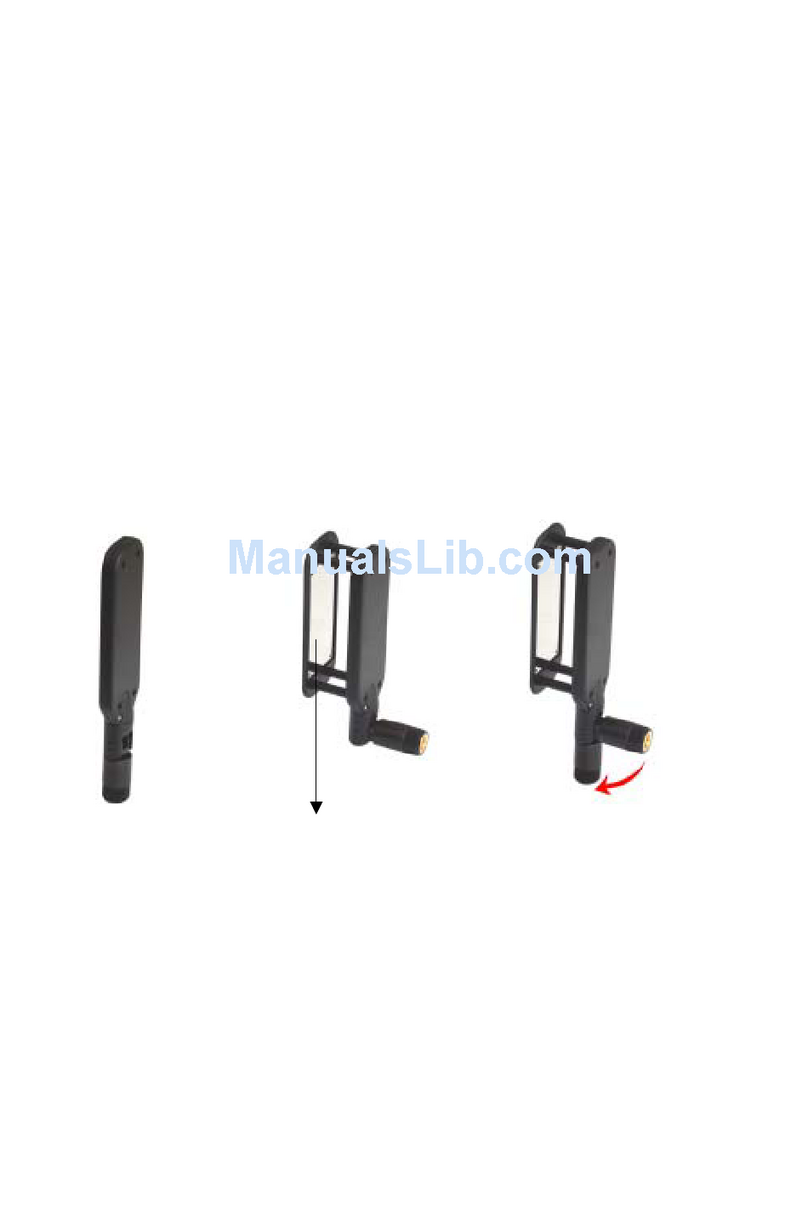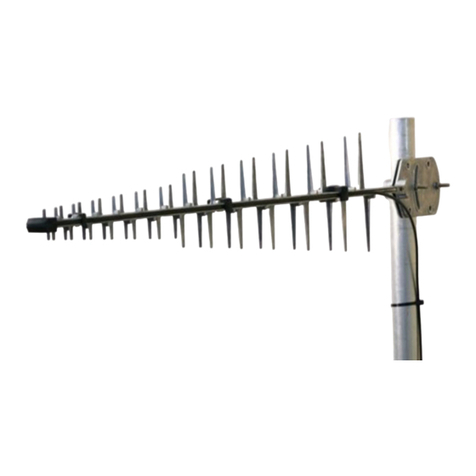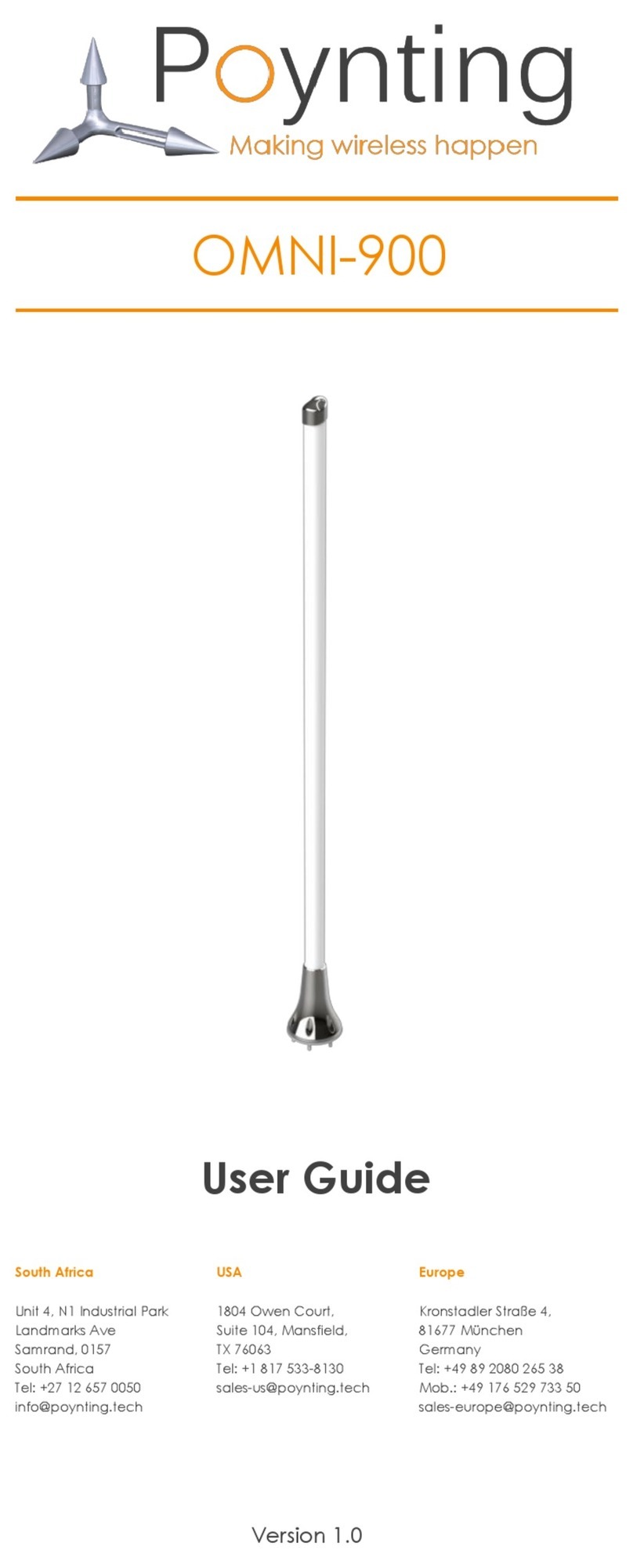General Dynamics SATCOM Technologies KX 120 Manual

Please include with this document the following manual(s):
400-0259
450-0001
450-0009
450-0072
460-0001
460-0009
460-0016
460-0043
DISCARD THIS PAGE BEFORE PRINTING

OPERATION & MAINTENANCE MANUAL
FOR
VERTEXRSI MODEL 11.1 METER
SATELLITE EARTH STATION ANTENNA
MODEL 11.1 KX 120/200
600-1152
Revision A
August 11, 2004
SATCOM Technologies
2600 N. Longview St., Kilgore, TX USA 75662-6842
Phone (903) 984-0555 yFAX (903) 984-1826
www.gdsatcom.com
"EXPORT CONTROL WARNING - the disclosure of this document or its contents to non-U.S. persons, or
the transmission of its contents outside the United States must be in compliance with U.S. Export Laws
and Regulations. The bearer of this document is under obligation to know the applicable restrictions for
the dissemination of its contents that relate to U.S. Export Laws and Regulations or any other U.S.
government approvals".


SATCOM TECHNOLOGIES CONFIDENTIAL AND PROPRIETARY
All computer software, technical data or other information pertaining to the equipment covered
by this document is considered proprietary by SATCOM Technologies. Such information
transmitted in this document or related documents is for the benefit of SATCOM Technologies
customers and is not to be disclosed to other parties verbally or in writing without prior written
approval of SATCOM Technologies. Additionally, this document may not be reproduced in
whole or in part without written consent from SATCOM Technologies.
A Original release 8/11/04 RSW JDT SPK
REV. DESCRIPTION DATE WRITER CHK. APPR.
600-1152A i

Use of WARNINGS, CAUTIONS, etc.
Warnings, Cautions and other notes are included throughout this document to provide
necessary information. IGNORING WARNINGS, CAUTIONS AND OTHER NOTES
MAY RESULT IN DAMAGE TO THE PRODUCT, INJURY, OR IN EXTREME CASES,
DEATH. You should know the use of Warnings, Cautions and other markings.
Definitions are:
WARNING! HIGHLIGHTS AN INSTALLATION, OPERATING OR MAINTENANCE
PROCEDURE, PRACTICE, CONDITION, STATEMENT, ETC., WHICH,
IF NOT STRICTLY OBSERVED, COULD RESULT IN INJURY TO OR
DEATH OF PERSONNEL.
CAUTION! HIGHLIGHTS AN INSTALLATION, OPERATING OR MAINTENANCE
PROCEDURE, PRACTICE, CONDITION, STATEMENT, ETC., WHICH,
IF NOT STRICTLY OBSERVED, COULD RESULT IN DAMAGE TO OR
DESTRUCTION OF EQUIPMENT OR THE LOSS OF MISSION
EFFECTIVENESS OR LONG TERM HEALTH HAZARDS TO
PERSONNEL.
Important: Highlights an essential installation, operating or maintenance
procedure, practice, condition or statement, which, if heeded, will
ensure efficiency and/or safety of said procedures.
Note: Highlights an installation, operating or maintenance procedure, practice,
condition or statement, which, if heeded, could enhance efficiency and/or
safety of said procedures.
ESD: The Electrostatic Sensitive Device (ESD) appears at the beginning of
any procedure or procedural step that includes the handling of
equipment sensitive to damage from electrostatic discharge.
General Warnings and Cautions are also provided at the front of the document. These
Warnings and Cautions should be read by anyone who is involved with installation, has
access to the equipment or is assigned to perform maintenance on the equipment.
600-1152A ii

CAUTIONARY NOTICE
Although SATCOM Technologies has attempted to detail in this document all areas of possible
danger to personnel in connection with the use of this equipment, personnel should use caution
when installing, operating and servicing this equipment. Care should be taken to avoid electrical
shock, whether the hazard is caused by design or malfunction. SATCOM Technologies is
specifically not liable for any damage or injury arising from a technician’s failure to follow the
instructions contained in this document or his failure to exercise due care and caution in the
installation, operation and service of this equipment. SATCOM Technologies shall not be
responsible for injury or damage resulting from improper procedures or from the use of
improperly trained or inexperienced personnel performing such tasks.
This document is intended as a general guide for trained and qualified personnel who are aware
of the dangers of handling potentially hazardous electrical and electronic circuits. This
document is not intended to contain a complete statement of all safety precautions that should
be observed by personnel in using this or other electronic equipment.
ELECTRICAL HAZARDS
The antenna and feed system supplied by SATCOM Technologies is designed to be integrated
with various types of electronic equipment. This system, if integrated with high power amplifiers
or traveling wave tubes, will be capable of transmitting microwave energy at varying power
levels. If transmitting microwave power, SATCOM Technologies cautions the end-user to review
all applicable local, federal and international regulations and to comply with all such regulations
in the operation and maintenance of the integrated system.
The electrical currents and voltages associated with this equipment, whether supplied by
SATCOM Technologies or others, are dangerous. Personnel must at all times observe safety
regulations.
•It is recommended that a lockout/tagout process be utilized while servicing the antenna
system. In the United States, see OSHA 1910.147.
•Always disconnect power before opening covers, doors, enclosures, gates, panels or
shields.
•Always use grounding sticks and short out high voltage points before servicing.
•Do not remove, short-circuit or tamper with interlock switches on access covers, doors,
enclosures, gates, panels or shields.
•Keep away from live circuits.
•Know your equipment and do not take risks.
•Always remove all power to the system prior to working on the antenna, the reflector
assembly, the reflector backup assembly or the feed assembly.
•Always tag all circuits noting that the power is OFF, the date and your name, prior to
commencing any work on that system.
In case of emergency, be sure that power is disconnected.
600-1152A iii

POTENTIAL DAMAGE TO ANTENNA
The antenna limit switches and resolvers have been pre-set to allow for maximum antenna
performance. Any subsequent adjustment may jeopardize antenna performance and/or result in
damage to the antenna.
SAFETY NOTICE
The following safety procedures are listed to remind those performing any work on the antenna
system that safety rules must be observed. Failure to observe safety rules may result in serious
injury or death. Always work safely and in accordance with established procedures.
•It is recommended that a lockout/tagout process be utilized while servicing the antenna
system. In the United States, see OSHA 1910.147.
•Care shall be taken in all operations to safeguard other people as well as property and
to comply with all local safety procedures as established by the customer’s site
representative, as well as local building codes and fire protection standards.
•All persons performing work on the antenna system shall also comply with the
Occupational Safety and Health Act (OSHA) standards and all other federal state and
local laws, ordinances, regulations and codes relating to designated work.
•Unless the customer’s representative on site specifically designates an individual
responsible for site safety, the SATCOM Technologies Site Supervisor shall be
responsible for and establish a site safety program for the SATCOM Technologies
installation work. The site safety program shall incorporate all SATCOM Technologies
safety procedures and requirements
•Never make internal adjustments or perform maintenance or service when alone or
fatigued.
ELECTROMAGNETIC RADIATION
•It is recommended that a lockout/tagout process be utilized while servicing the antenna
system. In the United States, see OSHA 1910.147.
•Do not stand in the direct path of the feed system when the system is transmitting!
•Do not work on the feed system when the system is on!
ALWAYS WORK SAFELY!
600-1152A iv

TABLE OF CONTENTS
1.0 INTRODUCTION .............................................................................................................1
2.0 ANTENNA COMPONENTS AND CHARACTERISTICS ................................................2
2.1 Pedestal Assembly ..........................................................................................................2
2.2 Reflector Assembly..........................................................................................................2
2.3 Elevation Drive Assembly................................................................................................3
2.4 Azimuth Drive Assembly..................................................................................................3
2.5 Polarization Drive Assembly............................................................................................3
2.6 Couplings.........................................................................................................................3
2.7 Limit Switches..................................................................................................................4
2.8 Angular Position Indication ..............................................................................................4
2.9 Reflector Backup Structure..............................................................................................4
2.10 Reflector Panels...............................................................................................................4
2.11 Subreflector Support Assembly........................................................................................4
2.12 Manual Operation of Drive Assemblies............................................................................5
2.13 Azimuth Jack Assembly Repositioning Procedure...........................................................5
2.14 Material Finishes..............................................................................................................6
3.0 RECOMMENDED MAINTENANCE SCHEDULES AND PROCEDURES......................7
3.1 Pedestal/Reflector Assembly Protective Finish ...............................................................7
3.2 Assembly Hardware.........................................................................................................8
3.3 Foundation Anchor Bolts (and other Galvanized Steel)...................................................9
3.4 Lubrication Schedule .......................................................................................................9
3.5 Jacks and Gearboxes......................................................................................................9
3.6 Bearing Lubrication........................................................................................................10
3.7 Elevation Axis Bearings.................................................................................................10
3.8 Azimuth Axis Bearings...................................................................................................10
3.9 Drive Assembly Bearings...............................................................................................10
3.10 Lightning Protection........................................................................................................13
3.11 Rod End Anti-Rotation Screw Adjustment......................................................................13
4.0 OPERATION..................................................................................................................15
4.1 Electrical Installation and Operation ..............................................................................15
5.0 WARRANTY..................................................................................................................16
600-1152A v

600-1152A vi
LIST OF FIGURES
Figure 1. Antenna Lubrication Points.........................................................................................11
Figure 2. Anti-Rotation Setscrew Location.................................................................................14
LIST OF TABLES
Table 1. Antenna Operating Conditions.......................................................................................2
Table 2. Lubrication Schedule ...................................................................................................12
Table 3. Jack Grease Chart.......................................................................................................13

600-1152A 1
1.0 INTRODUCTION
The purpose of this manual is to provide information for the operation and maintenance
of the Model 11.1-Meter KX 120/200 one (1) position and two (2) position antennas.
Should any repair or maintenance problems arise which are not discussed within this
manual, such problems should be referred to the equipment manufacturer:
General Dynamics SATCOM Technologies
2600 N. Longview St.
Kilgore, Texas 75662-6842
Telephone: (903) 984-0555
Fax: (903) 984-7597
A listing of antenna components and characteristics are included in this document.
Various operation and maintenance procedures are also included where applicable.
Refer to preceding Table of Contents to locate section(s) describing operational or
maintenance information required.

600-1152A 2
2.0 ANTENNA COMPONENTS AND CHARACTERISTICS
The VertexRSI Kingpost Pedestal Antenna is designed, engineered, and manufactured
for maximum life and minimum maintenance. The high gain feed system and rigid
reflector assembly are supported by the all-steel, four-point mount Kingpost Pedestal.
The design of the system assures the following operational and survival conditions.
Table 1. Antenna Operating Conditions
Condition Wind Velocity Gusts
Operational 30 mph (48 km/h) 45 mph (72 km/h)
Operational (Degraded) 45 mph (72 km/h) 60 mph (96 km/h)
Survival (any position) 125 mph (200 km/h)
This section lists a brief general description of the antenna system. More detailed
operation and maintenance instructions are covered in subsequent sections. All
pertinent antenna system drawings are referenced in the Project Print Pack shipped with
the antenna.
2.1 Pedestal Assembly
A two-axis elevation-over-azimuth kingpost pedestal is used to accurately position the
RF axis of the antenna. The assembly consists of all-steel construction and includes the
following:
•Kingpost pedestal
•Rear support legs (3)
•Jack drive assemblies
•Azimuth pintle assemblies
•Azimuth drive pivot (deadman) assembly
Damage, repair, or standard maintenance should be addressed of immediately on all
parts of the antenna structure to avoid any weather accelerated deterioration. Refer to
Section 3 for maintenance schedules and procedures.
Kingpost travel capabilities (1-position):
Elevation Axis Travel: 0° to 90° continuous
Azimuth Axis Travel: 120° continuous
Kingpost travel capabilities (2-position):
Elevation Axis Travel: 0° to 90° continuous
Azimuth Axis Travel: 200° total in two (2) segments of 120° each, 20° overlap
between the 120° segments.
2.2 Reflector Assembly
An 11.1-Meter diameter modified paraboloid reflector, constructed from 36 high accuracy
panels, is combined with a high performance cassegrain feed system to give maximum
efficiency with low sidelobes.

600-1152A 3
2.3 Elevation Drive Assembly
Basic characteristics of the elevation drive assembly:
a. Anti-Backlash Worm gear screw jack: Joyce Model AWJ1135-90 7/8
•Capacity: 35 Tons.
•Ratio: 11:1, 16 revolutions of the input shaft for 1 inch of jack extension
or retraction.
•Jack stroke: 94 ¾ inches with rod end and stop sleeve installed.
•Travel limits: External stop nut attached to the ends of jack screw.
b. Gearmotor: For job specific information, refer to the Print Pack shipped with the
antenna.
2.4 Azimuth Drive Assembly
Basic characteristics of the azimuth drive assembly:
a. Anti-Backlash Worm gear screw jack. Joyce Model AWJ1175-139 1/2
•Capacity: 75 tons.
•Ratio: 11:1 ratio, 16 revolutions of the input shaft for 1 inch of jack
extension or retraction.
•Jack stroke: 139 ½ inches with rod end and stop sleeve installed.
•Travel limits: External stop nut attached to ends of jack screw.
b. Gearmotor: For job specific information, refer to the Print Pack shipped with the
antenna.
2.5 Polarization Drive Assembly
(For LP Feeds With External Pol Drive Only)
Polarization rotation is accomplished by a motorized chain drive attached to the feed
support tube. The feed support tube turns on three (3) V-grooved rollers.
The drive assembly is powered by an electric motor that drives a dual-stage reduction
right-angle gear reducer with two (2) output shafts. A drive sprocket is attached to one
output shaft. The remaining output shaft drives an additional speed reducer (5:1) which
is coupled to the polarization drive transducer.
In this manner, a 1:1 ratio is obtained between the rotation of the feed tube (as turned by
the chain and drive sprocket) and the transducer. A limit switch provides an electrical
interlock.
Polarization drive speed is nominally 1° /sec.
2.6 Couplings
The gear motors are coupled to screw jacks with three-jaw finished bore couplings and
elastomer inserts. With the jaw-engaging couplings, there is no alignment necessary.
Each half is installed on its respective shaft. The insert is placed into either half and the
engagement is made when the gearbox is mated with its adapter flange.

600-1152A 4
2.7 Limit Switches
Limit switches are provided on the elevation and the azimuth ax’es to prevent structural
and/or electrical damage due to excessive rotation (overtravel) of the system. The limit
switches are activated by tripping the lever arm against an adjustable stop.
2.8 Angular Position Indication
Angular position is indicated by two size 11 (standard) transducers, size 20 (high
accuracy) transducers, or optical encoders. Position indicators are Control System and
application dependent. Refer to the PROJECT CONFIGURATION for the specific
Control System utilized. One transducer is mounted on each axis (azimuth and
elevation). Their electrical outputs are monitored as digital readouts integral with the
antenna position controller.
Additional optional position indication is provided by direct reading mechanical vernier
and protractor arrangements. These are available on both the azimuth and the elevation
axis. The protractor and the vernier are installed so that the scribed mark at zero (0) on
the protractor and the similar mark at zero (0) on the vernier are precisely aligned when
the antenna is at zero look angle (azimuth or elevation). For any rotation about either
axis, the mark at zero (zero mark) on the vernier will line up with the antenna look angle
(in degrees) on the protractor. When the zero mark on the vernier falls between two
degree marks on the protractor, the vernier may be read to determine the look angle to
the nearest five (5) minutes of arc. For example, if the zero mark on the vernier falls
between 23 degrees and 24 degrees on the protractor, and the mark at 15 on the vernier
is aligned with any mark on the protractor, the look angle is 23 degrees and 15 minutes
(23 and 15'). Note that while the vernier can be read on either side of the zero mark, it
should always be read in the direction of the increasing angle on the protractor.
2.9 Reflector Backup Structure
The reflector backup structure is comprised of 24 steel radial rib trusses emanating from
a center hub structure. Interconnecting hoop members are provided to furnish the
structure with maximum stiffness capability.
2.10 Reflector Panels
Thirty-six trapezoidal aluminum reflector panels are provided with each reflector. The
panels are designed to meet the stiffness and load requirements for the overall
specification. The panels will support a carefully placed 300-pound soft-bottom shoe
load without permanent deformation of surface accuracy
2.11 Subreflector Support Assembly
The subreflector support structure consists of four spars fastened together by an apex
assembly to form a space truss protruding from the main reflector backup structure. The
spars have been structurally optimized to minimize the RF blockage and relative
displacements between the subreflector, feed launcher, and main reflector axis.

600-1152A 5
2.12 Manual Operation of Drive Assemblies
The jack drive assemblies can be manually operated by means of a ratchet rotation or
an electric drill with a socket fitting on the end of the jack input shaft. It can also be
driven at the end of the motor shaft under the plug on the end of the fan shroud.
WARNING! LOCKOUT POWER TO SYSTEM PRIOR TO MANUALLY DRIVING
ANTENNA. REMOVE RATCHET/ELECTRIC DRILL FROM THE END
OF THE JACK INPUT SHAFT OR GEARMOTOR SHAFT BEFORE
RETURNING POWER. INJURY TO PERSONNEL AND/OR DAMAGE
TO THE EQUIPMENT MAY RESULT IF NOT REMOVED.
2.13 Azimuth Jack Assembly Repositioning Procedure
(Applies to 2-position antenna only)
When an azimuth look angle is desired which is outside the range of the existing jack
position, the following steps are the recommended repositioning procedures under calm
wind conditions (less than 10 mph / 16 km/h).
1. Clean the dirt and grease from the exposed portion of the azimuth jack screw.
2. Drive the reflector to its highest elevation look angle.
3. Disconnect azimuth limit switch.
4. Retract (or extend) the azimuth jack its full travel.
5. Secure antenna so that the pedestal cannot rotate in azimuth. This should be
done in a manner that will not damage the protective (paint or galvanizing) finish.
Note: One such securing method is to place a twelve-ton hydraulic jack
beneath the 1" thick plate on the bottom of the pedestal (the plate that
forms half the clevis for the azimuth jack trunnion), with a nominal 2"
wooden board between the jack and the pedestal bottom. Tighten the
jack until the wood shows some deformation, but avoid forcing the jack
until the wood splits.
6. Remove the six bolts securing the deadman pivot and azimuth jack to the
deadman base.
7. Extend (or retract) jack until the six bolt holes in the deadman pivot match the
corresponding holes in the deadman base in the adjacent position, rotating the
jack about its trunnion axis by hand.
8. Replace the six bolts, washers, and nuts that hold the deadman assembly
together with new hardware and tighten via turn-of-nut method.
9. Remove hydraulic jack or other means of securing method.
10. Connect and re-adjust limit switch, making sure limits are within travel range of
jack.
11. Recoat exposed jack screw with lubricant method mentioned in Section 3.5.

600-1152A 6
2.14 Material Finishes
2.14.1 Reflector panels
All aluminum materials have been cleaned, acid-dipped, and neutralized. The face of all
the reflector panels have a coat of flat white heat diffusing paint. For field touch-up of the
reflector surface refer to the following maintenance section starting on Page 3-1.
WARNING! HIGH GLOSS OR SEMI-GLOSS PAINT SHALL NOT BE USED ON
REFLECTOR PANEL FACE OR SUBREFLECTOR SURFACE.
2.14.2 Steel Structure
The steel structure of the VertexRSI KINGPOST PEDESTAL ANTENNA includes the
following:
a. Kingpost pedestal: Hot dip galvanized
b. Rear support legs: Hot dip galvanized
c. Jack drive assemblies: Primed and painted silver
d. Reflector backup structure: Hot dip galvanized
e. Ladders and platforms: Hot dip galvanized
2.14.3 Finish Options
As an option, some parts of the antenna structure may be painted after hot dip
galvanizing or painted with site specific colors. If any discrepancies occur that are not
specifically covered in the accompanying documentation or questions about a particular
finish arise, you may contact General Dynamics SATCOM Technologies Customer
Service.

600-1152A 7
3.0 RECOMMENDED MAINTENANCE SCHEDULES AND PROCEDURES
3.1 Pedestal/Reflector Assembly Protective Finish
The pedestal/reflector assembly should be inspected at least quarterly and should be
maintained as follows:
Note: The following describes processes and materials to repair finishes typical
to the standard product. In the event of a customer specific finish, please
refer to the accompanying documentation or contact General Dynamics
SATCOM Technologies Customer Service.
a. Remove accumulations of dirt and/or grease using a solution of hot water and
detergent. Follow cleaning with a clear water rinse.
b. Repair damaged or deteriorated surface finishes as follows:
3.1.1 Galvanized Steel, Reflector Back-Up Structure and Pedestal Assembly
Reference the following General Dynamics SATCOM Technologies documents and
procedure when touch-up of surface is necessary:
400-0259 Manufacturing Process Specification (Galvanized Surfaces Only)
450-0072 Paint Requirement (Painted Surfaces Only)
460-0043 Manufacturing Process Specification (Painted Surfaces Only)
a. Clean thoroughly using a solvent for greasy areas; hot water and detergent for dirt
accumulations.
b. Wire brush to remove oxidation.
c. 1. Where the galvanized finish is damaged, apply a coat of cold galvanizing type
paint, aerosol or liquid in accordance with General Dynamics SATCOM Technologies
procedure 400-0259.
2. Where the painted finish is damaged, apply a coat of gloss white per 460-0043.
3.1.2 Reflector Surface Panels (Painted Aluminum)
Reference the following General Dynamics SATCOM Technologies documents and
procedure when touch-up of surface panels is necessary:
450-0009 Paint Requirement (Flat White)
450-0072 Paint Requirement (Primer)
460-0009 Manufacturing Process Specification (For Coating Steel or Aluminum)
460-0043 Manufacturing Process Specification (Priming)
a. Lightly sand damaged area.
b. Clean sanded area to remove any particles left by sanding.
c. Apply one coat of primer.
d. Allow primer to air dry.
e. Apply the first coat of flat white paint.
f. Allow first coat of flat white paint to dry thoroughly.
g. Apply second coat of flat white paint.

600-1152A 8
3.1.3 Miscellaneous Painted Aluminum Components
Reference the following General Dynamics SATCOM Technologies documents and
procedure when touch-up of surface panels is necessary:
450-0001 Paint Requirement (Gloss White)
450-0072 Paint Requirement (Primer)
460-0009 Manufacturing Process Specification (For Coating Steel or Aluminum)
460-0043 Manufacturing Process Specification (Priming)
a. Lightly sand damaged area.
b. Clean sanded area to remove any particles left by sanding.
c. Apply one coat of primer.
d. Allow primer to air dry.
e. Apply the first coat of paint.
f. Allow first coat of paint to dry thoroughly.
g. Apply second coat of paint.
3.1.4 Miscellaneous Painted Steel Components
Reference the following General Dynamics SATCOM Technologies documents and
procedure when touch-up of surfacea is necessary:
450-0001 Paint Requirement (Gloss White)
450-0072 Paint Requirement (Primer)
460-0009 Manufacturing Process Specification (For Coating Steel or Aluminum)
460-0043 Manufacturing Process Specification (Priming)
a. Lightly sand damaged area.
b. Clean sanded area to remove any particles left by sanding.
c. Apply one coat of primer.
d. Allow primer to air dry.
e. Apply the first coat of paint.
f. Allow first coat of paint to dry thoroughly.
g. Apply second coat of paint.
3.2 Assembly Hardware
Assembly hardware shall be visually inspected quarterly at a minimum. Any hardware
which appears to be loose shall be tightened in accordance with AISC specification for
structural joints.
If a fastener is found to be damaged, it should be replaced with an identical fastener. For
high strength fasteners, the turn-of-a-nut method is recommended as the means for
providing the proper fastener tension as specified by the American Institute of Steel
Construction (AISC) in the Specification for Structural Joints Using ASTM A325 or A490
Bolts taken from the ninth edition of the Manual of Steel Construction, Allowable
Stress Design. Fasteners meeting the American Society for Testing and Materials
(ASTM) A325 Specification or the Federal Specification, FF-S-85C, for grade 5 steel, are
considered to be high strength fasteners.
Note: Galvanized ASTM A325 high strength structural bolts should not be
reused. Retightening previously tightened bolts which have been
loosened by tightening adjacent bolts are not considered to be a reuse.

600-1152A 9
3.3 Foundation Anchor Bolts (and other Galvanized Steel)
Deteriorated surface finish on protruding anchor bolts and other galvanized steel shall be
repaired as follows:
a. Clean thoroughly using a solvent for greasy areas; hot water and detergent for dirt
accumulations.
b. Wire brush to remove rust and oxides.
c. Apply a coat of a cold galvanizing type paint (either aerosol or liquid).
3.4 Lubrication Schedule
Table 2 identifies the items on the antenna which require lubrication. Figure 1 shows
typical locations and number of grease fittings. Table 3 identifies grease quantities
required for various size jacks. Refer to the installation assembly drawings for locations
requiring lubrication.
3.5 Jacks and Gearboxes
The gearing in the machine screw jacks must be lubricated with General Dynamics
SATCOM Technologies’ standard recommended grease which is Almagard #3751.
Refer to the Project Print Pack shipped with the antenna to confirm site specific
lubricants. For normal operation, jacks should be greased at least once a month. Under
severe use, (i.e. steptrack operation on one satellite or many changeovers between
satellites daily) jacks should be lubricated twice a month. There are three (3) grease
fitting locations on each Azimuth and Elevation machine screw jack. Two (2) are located
on the jackscrew housing near the input wormgear (driving) shaft. The third grease fitting
for the azimuth jack, as well as a removable plug (used to monitor the amount of
lubrication inserted into the housing), are located on the face of the of the jackscrew
cover tube where the cover tube fastens to the gearbox assembly housing. The thrid
grease fitting for the elevation jack is located on the face opposite the jackscrew cover
tube.
Prior to beginning the lubrication process, remove the plug mentioned above. Alternate
insertion of grease into the separate fittings. This will help to evenly distribute the grease
and make sure adequate lubrication has been provided. Continue lubrication until the
grease is forced out of the housing via the unplugged hole. Replace the plug.
Important: DO NOT MIX GREASES. Every two months, remove the boot. The
exposed jack screw should be cleaned and coated with a thin
coating of the Almagard #3751 grease.
The grease should be painted on with a paint brush so that a film of at least .03 inches
remains on all exposed surfaces of the jack screw and the boot replaced. Annually the
boot should be removed and the jack screw extended to the limit before cleaning and
coating. In this case, the housing lubrication should be delayed until after the boot is
replaced and the jack screw retracted to the operating point in order to insure maximum
grease retention.
Improved boot life can be obtained by coating the boot with a silicone-based protectant,
such as Armor All®, every two months.
The gearmotor lubrication levels should be checked at least every two (2) months and
new lubricant should be added as necessary. Refer to the Project Print Pack shipped

600-1152A 10
with the antenna for the proper lubricant. It is not necessary to change out the oil in the
gearboxes for the life of the antenna.
3.6 Bearing Lubrication
The following paragraphs describe the function, location, and lubrication of the remaining
moving mechanisms of the antenna system which require lubrication.
The bearings used on the pedestal assembly are the elevation axis bearing (2), the
azimuth axis bearing (2), and the elevation and azimuth drive jack rod end bushing (1).
Bearings should be lubricated at least every two months. Clean all dirt off the grease
fittings prior to lubricating bearings. Inject Almagard #3751 grease, using a conventional
pump-type grease gun.
3.7 Elevation Axis Bearings
The reflector is attached to the pedestal at the elevation axis through two self-aligning
spherical bushings, which are installed in the Pedestal Assembly.
The elevation axis grease fittings are located on the elevation lugs protruding from the
pedestal.
3.8 Azimuth Axis Bearings
The azimuth axis of the antenna is defined by the bearings at the upper and lower
pintles on the back side of the pedestal. The upper bearing is a self-aligning spherical
bushing. The lower pintle uses a radial bearing and a thrust bearing. Grease fittings are
provided on their respective housings.
3.9 Drive Assembly Bearings
A spherical plane bearing is used at the end of the elevation and azimuth jack screw
drive assemblies to provide pivoting action at this point.
The elevation drive assembly bearing grease fitting is located on the hub jack lug.
The azimuth jackscrew assembly bearing grease fitting is located at the azimuth
jackscrew rod end.

Figure 1. Antenna Lubrication Points
600-1152A 11
This manual suits for next models
1
Table of contents
Other General Dynamics Antenna manuals
